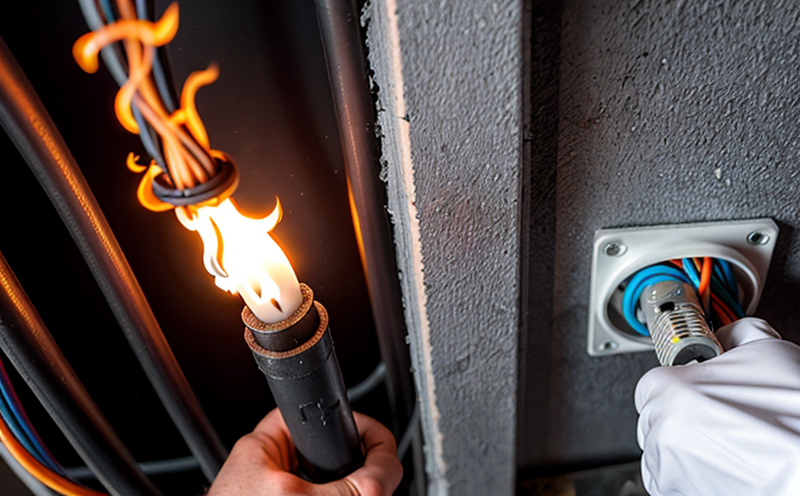Vertical Burn Testing of Cable Jackets
The vertical burn testing of cable jackets is a critical procedure in fire safety testing designed to evaluate the resistance of cable insulation materials against ignition. This test is particularly important for ensuring that cables and wiring systems meet stringent international standards, such as ISO 13943 or ASTM E84-18, which are widely recognized globally.
The test involves placing a sample of the cable jacket on a vertical surface and exposing it to a controlled flame. The objective is to assess how quickly the material ignites, the rate at which flames spread along the length of the specimen, and the extent of smoke and toxic gas emissions. Understanding these parameters helps manufacturers and regulatory bodies ensure that cables can withstand fire hazards without contributing significantly to the spread of fire or creating hazardous environments.
The testing process is meticulously controlled to simulate real-world conditions while maintaining consistency for comparison purposes. The flame source used in this test typically simulates a small open flame, which is applied at the bottom end of the cable specimen. The duration and intensity are carefully calibrated based on the specific requirements set by relevant standards.
Once ignited, the rate of spread along the length of the cable jacket is recorded using high-speed cameras or similar instrumentation. This allows for precise measurement of flame propagation speed. Additionally, sensors can be used to monitor the levels of smoke and gases released during combustion, which are crucial indicators of the material's fire resistance.
Following the test, the specimen undergoes detailed inspection for signs of damage, including singe marks, melting, or significant char formation. Compliance with standards like ISO 13943 requires that no more than a specified amount of flame should travel up the cable length within a given time frame.
- Flame Spread Index (FSI): This metric quantifies how easily the fire spreads across the surface. Lower values indicate better resistance to fire spread.
- Smoke Developed Index (SDI): Measures the amount of smoke produced by the burning material, which is vital for indoor installations where visibility and air quality are critical factors.
The results from vertical burn testing play a crucial role in ensuring that cables meet fire safety requirements. This can be particularly important in high-risk environments such as data centers, hospitals, and public transportation systems. By adhering to these tests, manufacturers ensure their products contribute positively to fire safety standards and help protect lives and property.
Benefits
The benefits of vertical burn testing extend beyond mere compliance with regulations; they offer significant advantages in enhancing product performance and reliability. Firstly, it ensures that the cable jackets are capable of containing fires effectively, thereby minimizing potential hazards. Secondly, this test helps manufacturers identify areas where improvements can be made to the design or composition of the cables.
By identifying weak points early on through rigorous testing, companies can implement necessary changes to enhance fire resistance. This proactive approach not only improves product quality but also strengthens brand reputation by demonstrating commitment to safety and sustainability. Additionally, successful passage in these tests can open up new market opportunities, especially in sectors where stringent fire safety measures are mandatory.
From an operational perspective, the insights gained from vertical burn testing enable better decision-making regarding material selection and process optimization. For instance, understanding the thermal properties of different materials allows for more informed choices during product development stages. Furthermore, this information aids in predicting how the cables will behave under various conditions, leading to improved overall performance.
In summary, incorporating vertical burn testing into production processes is an essential step towards building safer and more reliable products that meet industry standards and public expectations.
Quality and Reliability Assurance
- Consistency in Results: Ensuring consistent outcomes across multiple tests helps maintain product quality. By adhering to standardized procedures, laboratories can deliver reliable data that is repeatable and comparable.
- Compliance with Standards: Meeting the stringent requirements set by international standards such as ISO 13943 ensures that products are suitable for use in diverse applications worldwide.
- Data Accuracy: Precise measurements of flame spread and smoke development contribute to accurate assessment of material performance, supporting informed decision-making.
In addition to these technical aspects, maintaining a robust quality assurance system also includes regular calibration of testing equipment, training of personnel on the latest techniques, and adherence to best practices in laboratory management. These measures ensure that every test conducted adheres to high standards, thereby building trust with clients and stakeholders.
Environmental and Sustainability Contributions
The environmental impact of fire safety testing is an increasingly important consideration for modern laboratories. By focusing on minimizing waste and optimizing resource use, these institutions contribute positively to sustainability efforts.
Efficient sample preparation methods help reduce the amount of materials discarded during testing. Additionally, advanced recycling processes allow for repurposing unused samples or components, further reducing environmental footprint. Furthermore, adopting energy-efficient practices in laboratory operations reduces carbon emissions associated with facility maintenance and operation.
From a broader perspective, successful vertical burn testing plays a key role in promoting safer communities by preventing fires from spreading rapidly through building infrastructure. This contributes significantly to disaster risk reduction strategies aimed at protecting human lives and property. Moreover, compliant products contribute towards creating healthier indoor environments, which is particularly beneficial for vulnerable populations like elderly individuals or those with respiratory conditions.
By integrating sustainable practices into fire safety testing protocols, laboratories not only enhance product quality but also promote responsible environmental stewardship, aligning with global commitments to reduce carbon footprints and improve overall ecological health.





